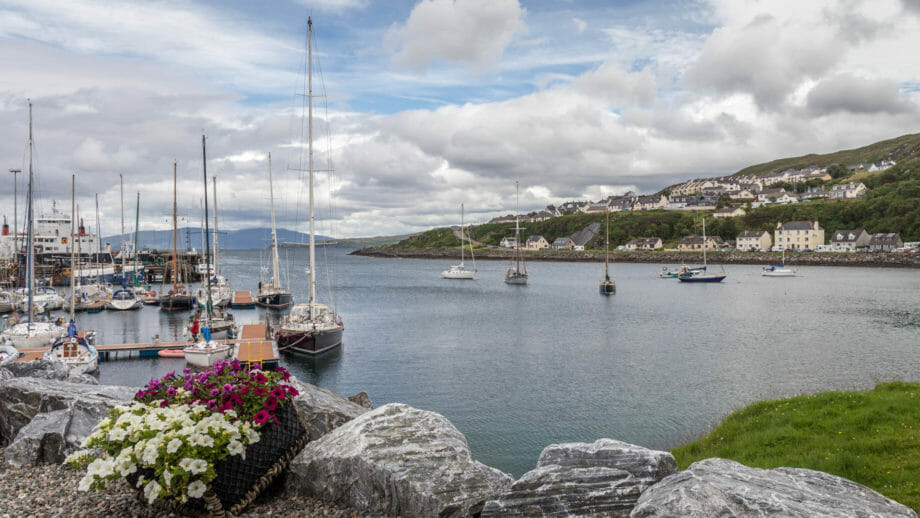A lively fishing village at the end of a dream route through the Highlands. Mallaig, in the west of Knoydart, offers good reasons to visit.

Mallaig is something of a secret Highlands transport hub: it’s where the Jacobite Steam Train and the Road to the Isles terminate, only to be followed by ferry services to the Isle of Skye and many small islands such as Mugg, Eigg and Rùm.
Never the less, Mallaig invites you to linger. Almost compulsorily for some – the Jacobite Steam Train takes an extended break here, where the locomotive is re-harnessed. And many ferry passengers use the waiting time until departure for a little stroll.
Mallaig doesn’t offer any great sights. Nor is the village an ancient beauty with grand architecture. No, Mallaig is home to dock workers, fishermen and boat builders. And it lets the visitor feel that.
The connection to the sea is also shown by the Mallaig Heritage Centre, located just off the train station, which teaches the history of Mallaig and the Morar area.
What the fishermen catch can, of course, be eaten in Mallaig. Nearly twenty restaurants, bars and stalls offer seafood and other food.
From Mallaig, visitors can also explore Morar. The Silver Sands of Morar are not far away and there are boat tours into Loch Nevis.
Knowledge: Mallaig’s (short) history
Like the town of Ullapool, for instance, the village of Mallaig is a foundation during the Highland Clearances. In 1840, the Thomas Fraser, 12th Lord Lovat decided to divide up his lands. At the time, there were many farmers living on relatively fertile land at Loch Morar and Loch Nevis. But Lovat wanted or needed to make his lands more profitable. And so he pushed the farmers off the land and into a settlement to the west of the Knoydart peninsula, where they would henceforth be engaged in fishing rather than farming.
After only ten years, 134 people had settled here – as planned as fishermen. And the Lovats continued to look after the little harbour. So a pier was built, still known today as Lovat Pier.
But even more important to the development of Mallaig was the railway. Lord Lovat fought for the line – after all, he had seen how much Oban had changed as a result of the link. Lovat was successful: in 1901 the line between Fort William and Mallaig was opened. The trains brought workers and soon tourists. And they picked up seafood to transport to inland markets. In the process, they were often smoked while still in the village.
Boats also changed from sailboats to steamships. This allowed them to access more fishing grounds in more distant waters. Mallaig was booming.
In 1932 the first car ferry was put into service, linking Mallaig (as it still does today) with Armadale on Skye, just over 7 kilometres away.
In 1960, finally, Mallaig was THE port. Ferries were leaving not only to Skye but also to the Outer Hebrides and fishing was at its peak. But in the 1970s things went downhill: for one thing, fishing quotas were introduced because of overfishing. And due to the greater importance of cars and roads, Mallaig lost important ferry connections to Kyle of Lochalsh or Oban. Even the rail link was facing extinction.
But another boom was setting in: Tourism to the Highlands began to take off in the 1980s. In 1984, the Jacobite Steam Train was put on the line to Mallaig, and the Road to the Isles was promoted as a scenic road. And so Mallaig today, with a population of around 800, is smaller than it used to be, but quite healthy as a community. At the same time, Mallaig relies not only on tourism, but also continues to rely on fishing.
In 2013, the community made this connection to fishing even clearer with a memorial. The wooden statues, by artist Iain Chalmers, stand near the harbour and commemorate all those who “stayed at sea.”
By the way, the name Mallaig – or Gaelic “Malaig” – is considered impossible to translate with any certainty. It could be a compound of “Mal” – “gravel” and the Old Norse “Vik” – “bay”.
approach
With satnav: “PH41 4PX” enter and drive off.
Without sat nav: Coming from Fort William, take the A830. Stay on it and don’t turn off – this will take you to Mallaig.
Parking: There is a large car park on the left just as you enter the village. Mallaig is easily explored on foot from here.